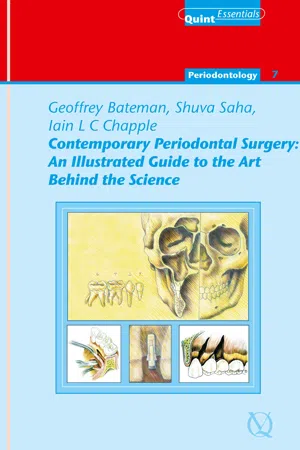
eBook - ePub
Contemporary Periodontal Surgery
An Illustrated Guide to the Art behind the Science
This is a test
- 204 pages
- English
- ePUB (mobile friendly)
- Available on iOS & Android
eBook - ePub
Contemporary Periodontal Surgery
An Illustrated Guide to the Art behind the Science
Book details
Book preview
Table of contents
Citations
About This Book
This book aims to provide an evidence-based and highly illustrative approach to a comprehensive repertoire of surgical procedures, including: basic principles, resective surgery, regenerative techniques and periodontal/peri-implant plastic surgery. It emphasizes the importance of case selection and planning to successful outcomes and extols the benefits of microsurgical instrumentation. The distinction between periodontal and other forms of oral surgery is made, principally that in periodontal surgery, the contour and quality of the tissues post-operatively is vital to longer-term success and therefore careful soft tissue management is pivotal.
Frequently asked questions
At the moment all of our mobile-responsive ePub books are available to download via the app. Most of our PDFs are also available to download and we're working on making the final remaining ones downloadable now. Learn more here.
Both plans give you full access to the library and all of Perlego’s features. The only differences are the price and subscription period: With the annual plan you’ll save around 30% compared to 12 months on the monthly plan.
We are an online textbook subscription service, where you can get access to an entire online library for less than the price of a single book per month. With over 1 million books across 1000+ topics, we’ve got you covered! Learn more here.
Look out for the read-aloud symbol on your next book to see if you can listen to it. The read-aloud tool reads text aloud for you, highlighting the text as it is being read. You can pause it, speed it up and slow it down. Learn more here.
Yes, you can access Contemporary Periodontal Surgery by Geoffrey Bateman, Shuva Saha, Iain L. C. Chapple in PDF and/or ePUB format, as well as other popular books in Medicine & Oral Health & Surgery. We have over one million books available in our catalogue for you to explore.
Information
Chapter 1
Principles and Practice of Periodontal Surgery 1: Case Selection and Planning
Aim
The aim of this chapter is to provide the reader with a philosophy for case selection and treatment planning in periodontal surgery. Treatment objectives for predictable surgical management will be detailed alongside the principles common to different surgical procedures.
Outcome
Having read this chapter the reader will be able to carefully plan a surgical case and identify potential pitfalls on a case-by-case basis. The standardised evidence-based protocols described will help to enhance the operator’s existing surgical preparation, irrespective of the type of surgery planned.
The Art and Science of Surgery
Periodontal surgery is both a science and an art. The periodontal surgeon should be both knowledgeable and ready to adapt their practice in line with the best research evidence. They should be able to critically appraise this evidence in an objective manner. In addition, the technical aspects of surgery require fine motor skills, gentle tissue handling and the visual anticipation of how a flap will close: this is the art of surgery. Surgical management requires a marriage of both of these facets, if excellence is to be achieved. Surgical skill comes through both didactic and observational learning, thorough experience and, to a lesser extent, the surgeon’s innate dexterity. The importance of education, therefore, cannot be overstated.
The other key aspect of good surgical management is regular practice to guard against de-skilling. The practitioner should be ready to appraise their own abilities and not undertake cases beyond their limits of competence; these may change throughout the course of their career.
The archetypical Renaissance man, Leonardo da Vinci, was an example to modern-day surgeons. In his era, science and art were not regarded as mutually exclusive entities. His studies in science and engineering were as accomplished as his drawing and painting. Leonardo’s drawing skills developed through his study of anatomy. A reproduction of one of his head and neck dissections may be found on the front cover of this text.
The Right Procedure
It is axiomatic that careful diagnosis and prescription of the right procedure are a sine qua non of surgical management. Future chapters will explore a selection of more popular surgical techniques and their indications in greater depth. The dental surgeon should be aware, however, of the nature and sequelae of the proposed treatment and be competent to carry out that treatment where appropriate. It follows that a full and frank discussion with the patient is necessary to gain informed consent. Informed consent should detail benefits, risks, other treatment options to be considered and what will happen if treatment is not carried out. Under common law, a conscious and competent patient needs to provide verbal consent to any operative procedure, although where sedation or deeper anaesthesia is employed, written consent is mandatory. Patients should also be provided with a written treatment plan and an estimate of costs.
The Right Patient
Appropriate patient selection is important if high success rates are to be achieved and maintained with surgery. There are few absolute contraindications to surgery in general dental practice.
Common contraindications include:
- severe bleeding diatheses
- congenital, e.g. haemophilia and von Willebrand’s disease
- acquired, e.g. warfarinised patient with a high INR (international normalised ratio ≥ 3.5)
-
- significantly immunocompromised patients, e.g. acute leukaemia
- unstable angina
- poorly controlled diabetes
- uncontrolled hypertension.
With few exceptions, periodontal surgical procedures are elective in nature. All attempts should be made, therefore, to postpone surgery for medically compromised patients until such time as systemic complications are stabilised.
Those patients with relative contraindications require careful consideration. These include medical, social and compliance-related factors.
In the United Kingdom, management of patients who require antibiotic prophylaxis for endocarditis has been greatly simplified through the introduction of new guidelines from the British Society of Antimicrobial Chemotherapy (BSAC) (Gould et al., 2006). These guidelines have not, however, been universally accepted at the time of this book going to press.
Patient groups requiring antibiotic prophylaxis have been reduced to three:
- those with previous endocarditis
- those with heart valve replacement
- those with surgically constructed systemic or pulmonary shunts.
All dentogingival manipulations for these patients require antibiotic cover. There is no longer a need to provide intravenous antibiotic cover; oral antibiotic cover is now considered sufficient. Older BSAC guidelines are still published in the British National Formulary (BNF), and medicolegally either is acceptable as the guidance and advice of a recognised and properly constituted expert group.
Other relative medical contraindications should be considered practically on a case-by-case basis and treatment provided following careful appraisal of risks and assessment of response to previous surgical intervention.
Addiction poses particular problems in the management of surgical patients. Smoking is a significant risk factor for periodontal surgical failure and failure of implant placement. Alcohol dependence will predispose to excess bleeding where liver function has been impaired. It is important to consider that patients with liver disease may be thrombocytopenic as well as having abnormal clotting factor levels. In such cases, a full blood count must be taken in addition to an INR (prothrombin time). Platelet levels below 60,000/ml of whole blood represent a risk for surgical intervention. The disordered lifestyle led by some alcoholics may compromise the delivery of the planned regular care necessary for surgical success. It may be sensible to suggest other treatment approaches for these patients.
Phobic patients or those with poor compliance are generally less suitable for periodontal surgery than others. Often these procedures may be relatively time-consuming and technically demanding for the operator. Whilst conscious sedation techniques may render treatment possible for these patients, anxiety and poor coping skills may render the post-surgical phase relatively stormy and future management more difficult. Again, simpler, nonsurgical treatment options may be more appropriate for such patients.
Preoperative Management
Careful preoperative management and planning will often simplify surgery itself and allow a more predictable post-operative healing phase. Meticulous record-keeping and the use of evidence-based practice should be observed in this regard.
Record-Keeping
As discussed previously, the informed consent process is vital and should be well documented. General risks are involved in any surgical procedure and should be discussed with the patient. These include pain, swelling, bruising and bleeding. Many of these can be minimised with careful technique. Risks specific to the particular procedure should also be discussed. These include, for example, gingival recession in areas of aesthetic importance and the potential for paraesthesia where surgery is in close proximity to neurovascular bundles. Consent forms are a useful adjunct in the consent process where sedation or general anaesthesia is contemplated. A copy should be retained in the patient notes and another given to the patient.
Where aesthetic change is planned or is a risk, it is valuable to obtain photographic records so that before and after comparisons may be made. Study models are also helpful in this regard. Recession defects, for example, may be monitored over time and assessed for change after surgery. Where there is chronic periodontitis, as a minimum standard an up-to-date detailed pocket chart should be recorded before any surgery is planned. Good quality contemporary radiographs are an invaluable patient record, as well as a useful aid for diagnosis and surgical planning.
Antimicrobial Chemotherapy
Periodontal inflammation is most frequently plaque-induced. Whilst surgical insult to oral mucosal tissues will also induce an inflammatory response, this will be amplified by poor preoperative plaque control and prolonged by inadequate post-operative cleaning. Prolonged inflammation will potentiate post-operative discomfort and compromise healing by primary intention.
It is important to ensure that oral hygiene is optimal prior to surgery. A 0.2% chlorhexidine gluconate mouthwash (Fig 1-1) four times daily (q.d.s.) one week prior to and two weeks post-surgery is invaluable in this respect. This has been shown to reduce discomfort and promote healing (Newman and Addy, 1982). In addition, chlorhexidine used immediately preoperatively has been shown to reduce the bacterial load and aerosol contamination of the operative area and surrounding environment.

Fig 1-1 Generic chlorhexidine gluconate 0.2% mouthwash. The use of generic products, where possible, is most cost-effective.
Analgesia
The notion of pre-emptive analgesia is growing in importance in surgical management. This is based on the principle that preoperative administration of NSAIDs (non-steroidal anti-inflammatory drugs) will diminish the tissue response to the cascade of pain messengers induced by surgical insult. This in turn will reduce the potential for peripheral or central sensitisation to pain and prolonged post-operative discomfort. The beneficial use of preoperative NSAIDs has been demonstrated in a number of studies. The authors would recommend a single dose of 800 mg ibuprofen preoperatively where appropriate. Currently, this drug and dosage taken three times daily represent the gold standard for pain relief. British National Formulary (BNF) guidelines would suggest comme...
Table of contents
- Cover
- Title Page
- Copyright Page
- Table of Contents
- Foreword
- Preface
- Acknowledgements
- Chapter 1: Principles and Practice of Periodontal Surgery 1: Case Selection and Planning
- Chapter 2: Principles and Practice of Periodontal Surgery 2: Basic Surgical Principles
- Chapter 3: Surgical Management of Gingival Overgrowth
- Chapter 4: Access Flaps for Surgical Root Surface Debridement
- Chapter 5: Regenerative Periodontal Techniques
- Chapter 6: Periradicular Surgery
- Chapter 7: Resective Hard Tissue Surgery
- Chapter 8: Crown-lengthening Surgery
- Chapter 9: Mucogingival Grafting Procedures – An Overview
- Chapter 10: Hard Tissue Surgery (Ridge Augmentation) for Dental Implants
- Chapter 11: Soft Tissue Surgery Around Dental Implants